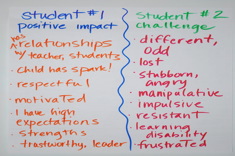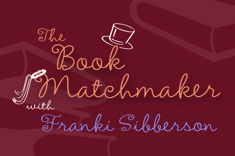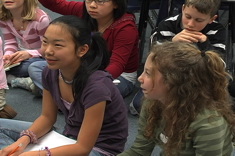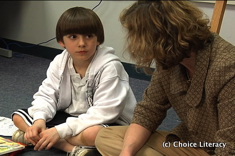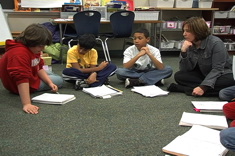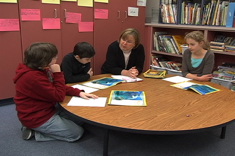Struggling and Striving Learners
It's hard work, it matters . . . and nothing brings more joy than reaching a child who is struggling. The problem is each of these students presents a unique array of challenges and needs that don't allow for a uniform approach. Here are the stories from our contributors of their breakthrough moments, one child at a time.
Latest Content
How to Look at Student Work
With summaries as an example, Heather Rader uses trends from learners to help make smart instructional decisions about what is presented during whole group, small group and individual time.
The Power of Linking Words and Perceptions
Melanie Quinn relays a powerful practice for staff members to reframe language and perceptions while putting common labels for students in a whole new light.
No More Excuses: Reading Workshops in Nontraditional Middle and High School Settings
Think you don’t have enough time for reader’s workshop in your classroom? Worried that you don’t have enough books to go around? Feel like you just don’t have the space for it? What if you had students, but no classroom, no books, and no set class times? Ellie Gilbert faced down all these challenges in her nontraditional high school reading workshop.
Coaching Reluctant Writers
Heather Rader describes how to use "wows and wonders" to reach students who say they hate to write.
Spring Slump
Audrey Alexander takes a close look at a couple of the students in her self-contained resource room, and finds the observations renew her flagging energy.
Book Matchmaker: Helping a Struggling Reader in 5th Grade
In this installment of Book Matchmaker, Franki Sibberson shares books and genres a struggling 5th grader might enjoy.
Book Matchmaker: Short Vowel Practice with Older Students
In this installment of Book Matchmaker, Franki Sibberson tackles the tough question of how to find texts for students who need help with short vowels, but are too old to enjoy many primary texts.
Reorganizing Books in the Reading Support Classroom
Katie DiCesare helps her mom, a reading support teacher, reorganize her materials to better serve students.
Coaching Beyond the Curriculum: Reframing Our Talk and Attitude Toward Difficult Students
What role should literacy coaches have in helping teachers manage unruly students? Melanie Quinn settles into a morning of poring over assessment data, only to have it interrupted by a child who has been disrupting his class. Her interactions with Darren and his teacher lead to strategies for helping colleagues take an inquiry stance with challenging children.
Helping Students Deal with Distractions
Clare Landrigan and Tammy Mulligan offer lesson suggestions for helping students self-monitor and deal with distractions during literacy workshops.
Teaching Revision to Struggling Writers
Clare Landrigan and Tammy Mulligan offer three strategies to use during writing conferences with struggling students.
A Thanksgiving Take on Differentiating Instruction
Kathy Collins looks around the holiday table and discovers that differentiating instruction is similar to hosting a Thanksgiving feast.
Unlucky Lists: Raising Non-Writers and Non-Artists
These lists created by S. Rebecca Leigh are a fun way to size up the messages we send students about reading, writing, and drawing, and how these may influence lifelong literacy habits.
Understanding Students in Intervention Programs
Using data to make wise decisions about students who are struggling is one of the most important tasks in schools. In this series, Clare Landrigan and Tammy Mulligan take you through the process of linking data to instruction plans in intervention programs.
Ecstatic: When Words Shape Thinking
Carol Wilcox prepares her struggling intermediate readers for state exams, and finally experiences a breakthrough in linking vocabulary learning to authentic reading.
5th Grade Grandfather
Misunderstandings abound when working with struggling readers and writers. Jennifer Jones connects an experience in her personal life to one student she is supporting and gains new insight.
Overcoming Slumps: Principles for Student Writers
Clare Landrigan finds she is struggling as a writer and runner. Getting out of both ruts helps her develop three simple principles for working with students in slumps.
Are You Scaffolding or Rescuing?
How much is too much support while conferring? Terry Thompson explores the language of scaffolding and rescuing.
What’s the Most Beautiful Thing You Know About…?
Ruth Shagoury and Melanie Quinn asked their colleagues to share the “most beautiful thing” about the puzzling student each of them is looking at closely in their study group. This is a great activity you’re looking for a quick and easy icebreaker to spark some positive energy in your next study group or staff meeting, and remind everyone of the joys of our profession.
Aligning Curriculum with Struggling Readers in Mind
This is a terrific article for a team considering struggling learners to read together and discuss. Franki Sibberson asks some critical questions, including how many transitions and different adults some children work with each day in the name of getting all the support they need.
How Can School and Classroom Libraries Support Struggling Readers?
Franki Sibberson tries to imagine what school and classroom libraries look like to struggling readers who are gazing at scores of books beyond their reading levels.
Animals as Ambassadors: Using Class Pets to Reach an English Language Learner
When a student is struggling, language barriers can make it even harder for teachers to connect. Andrea Smith finds webbing during conferring is an excellent strategy for assisting a young English language learner in her writer's workshop.
What My Son’s Reading Difficulties Taught Me About Teaching Struggling Readers
No matter how many education methods courses and professional development workshops you take, if you’re a parent, your children will always teach you the most about how students learn. Tammy Mulligan shares three practical strategies for reaching struggling readers that she learned from experiences with her son.
Why and Watch Me: Making the Abstract Concrete for Readers
Clare Landrigan and Tammy Mulligan present some teacher question and reflection prompts for helping struggling readers understand why and how reading is a meaning-making process.
Staying True to Our Beliefs When Working With Struggling Readers and Writers in Grades 3-6
Franki Sibberson writes about the challenges of holding true to our beliefs in working with struggling readers, and shares the questions she asks herself as a way of self-monitoring her teaching with strugglers.
Fitness Boot Camp Helps Me Understand Struggling Readers
Franki Sibberson finishes 29th out of 30 participants in her fitness bootcamp mile run. In the process, she learns many lessons about herself and the needs of struggling learners in her classroom.
Forming Teams to Help Struggling Readers:A Pilot Project (TEMPLATES)
Andrea Smith shares observation strategies used within a teaching team. The article includes templates developed by the group.
Helping Struggling Writers
How can we help students who are stuck when it comes time to write? Franki Sibberson shares a couple new strategies, including a book basket of texts selected by students themselves as useful for sparking writing topics in this photo essay.
5th Grade Strategy Group on Summarizing
In this strategy group, Karen Terlecky brings together three of her 5th graders to reread a nonfiction article shared with the whole class. They discuss main ideas, and do a writing activity together to build summarizing skills.
Case Studies in Professional Learning Communities
In this brief video, Literacy Coach Pam Hahlen and Principal Karen Szymusiak meet with two teachers in a professional learning community group to discuss ongoing case studies.
Browse Content By
Type
Category
- Assessment Tools
- Big Fresh Archives
- Booklists
- Choice Numeracy
- Classroom Design
- Common Core
- Community Building
- Conferring
- Content Literacy
- Digital Literacy
- English Language Learners
- Equity
- Family Relations
- Free Samples
- Guiding Groups
- Leadership
- Literacy Coaches
- Mentor Texts
- Minilessons
- New Teacher Mentors
- Podcasts
- Poetry
- Quote Collections
- Reading Strategies
- Self Care
- Struggling and Striving Learners
- Talking and Listening
- Teacher Study Groups
- Teaching Reading
- Teaching Writing
- Word Study and Vocabulary
Author
- Melissa Quimby
- Nawal Qarooni
- Gwen Blumberg
- Julie Cox
- The Lead Learners
- Hannah Tills
- Josie Stewart
- Ruth Metcalfe
- Mallory Messenger
- Becca Burk
- Jodie Bailey
- Vivian Chen
- Mary Brower
- Tiffany Abbott Fuller
- Stephanie Affinito
- Ruth Ayres
- Leigh Anne Eck
- Heather Fisher
- Shari Frost
- Julie Johnson
- Suzy Kaback
- Gigi McAllister
- Shirl McPhillips
- Melanie Meehan
- Cathy Mere
- Debbie Miller
- Tara Barnett and Kate Mills
- Tammy Mulligan
- Dana Murphy
- Bitsy Parks
- David Pittman
- Brenda Power
- Heather Rader
- Matt Renwick
- Mandy Robek
- Christy Rush-Levine
- Gretchen Schroeder
- Jen Schwanke
- Brian Sepe
- Katherine Sokolowski
- Stella Villalba
- Jennifer Vincent
Grade Level
Choice Literacy Membership
Articles
Get full access to all Choice Literacy article content
Videos
Get full access to all Choice Literacy video content
Courses
Access Choice Literacy course curriculum and training


